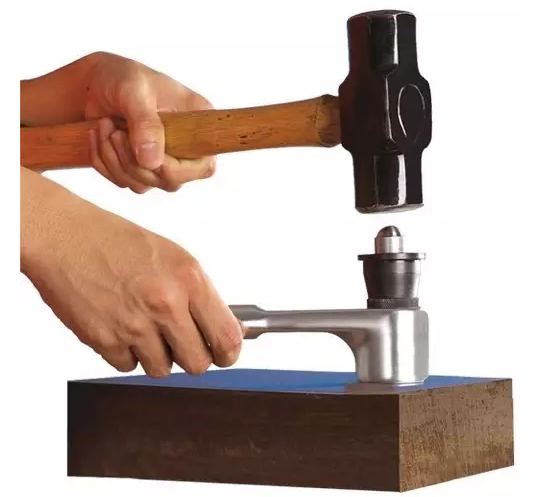On - Site Brinell Hardness Test Technology (1)
With the development of manufacturing, its requirements to the quality of raw materials and parts are getting higher and higher. In metallurgy, electricity, petroleum machinery, rail vehicles, automobiles, military equipment and other fields, the production site detection of the body hardness of metal materials and large parts are required. In particular, some requires the detection of many products and some also require piece by piece detection.
In recent years, with the rapid development of on-site Brinell hardness testing technology, new technologies are endless and many shortcomings has been overcome.
1 Impact Brinell hardness tester (formerly known as portable Brinell hardness tester)
The impact type Brinell hardness tester showed in figure 1 is a small simple device. The device has a spring, a spring compression and release mechanism inside. And the device has a steel ball at the end. While testing, pressure the device slowly, the spring was first compressed, and then release, while the impact push ball into the specimen surface and left indentation. The indentation diameter was measured with a digital microscope, and then obtain the Brinell hardness values from the table. The National Metrological Verification Regulation JJG 870-1994 specifies the method for the verification of such instruments.
The impact Brinell hardness tester is easy to use with simple structure and low price; but the test force is uncertain, thus the test error is large, the accuracy is ± 8%. It can only be applied to the the occasion with low accuracy of Brinell hardness measurement. This instrument technology has been less used in the production site, as it is too old and its stability is less than hammered Brinell hardness.

2 Hammer impact Brinell hardness tester
Hammer impact Brinell hardness tester showed in figure 2 is composed of the bracket, steel ball, bar hardness blocks and others. While testing, use a hammer to hit the top of the bracket, the impact force on the ball will be applied to the specimen and the hardness block, and left indentation on the specimen and the hardness block. The two indentation has a certain proportion, then measure the diameter of two indentation and look-up table for Brinell hardness value. American Standard ASTM A833-08a (2014) provides the test method, the national measurement procedures JJG 411-1997 provides a test method for the instrument.
The hammer impact Brinell hardness tester is easy to use with simple structure and low price. However, the test force is uncertain, the test error is large, the precision is ± 8%, and the precision of the strip hardness is ±4%. This kind of instrument can only be applied to the occasions with low Brinell hardness measurement accuracy, as it is lower than ordinary Brinell hardness block. Currently, hammer impact Brinell hardness tester is widely used in the production site of domestic casting, forging, rolling, heat treatment and other industries.

3 Cut pin hammer impact Brinell hardness tester
Cut pin hammer impact Brinell hardness tester is showed in figure 3 and its structure is showed in figure 4. It is composed by the shear frame, cut pin, spherical pressure head, sleeve and support handle. While testing, the cut pin and the indenter is mounted on the shearing frame, the shearing frame is put into the sleeve, the sleeve is put into the support handle, and then put on the specimen. The hammer is used to hit the top of the shearing frame, the test force is transferred to the indenter through the cut pin, the spherical end of the indenter is pressed into the specimen, leaving indentation on the surface of the specimen. When the knocking force reaches the rated cutting force of 15494 N (1580 kgf), The press is instantly cut off by the shear system consisting of the shearing frame and the indenter. The indenter is retreated into the shearing frame and the test force disappears. The actual test force on the indenter is exactly 15494 N (1580 kgf), mark the diameter, and then look at the table for Brinell hardness value.
The Cut pin Brinell hardness tester conforms to the Similarity Principle of Brinell Hardness Test. The test force F = 15494 N (1580 kgf), the pressure head diameter D = 7.26 mm, the F / D2 value is equal to 30, the test conditions are equivalent to 29420 N (3000 kgf) test force, diameter 10 mm ball head.
The Cut pin type Brinell hardness use static afterburner shown in Figure 5.

Cut pin type Brinell hardness tester is easy to use with simple structure. Its principle is closer to Brinell hardness test principle with high reliability. Instrument test force is accurate, the test results has good repeatability and high precision, hammering force method error is less than ± 5%, static afterburner mode error is less than ± 3%. The kind of equipment has a wide range of applications in Europe and the United States. Now our country has now produced.
The JJF ×××× "Portable Brinell Hardness Tester" on drawing specifies the calibration methods for the three dynamic afterburner hardness gauges and will replace JJG 870-1994 and JJG 411-1997.